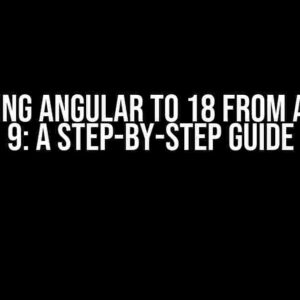As a developer, you’re probably no stranger to the world of Vite and its versatile plugins. One such plugin, vite-plugin-lib-inject-css, has gained popularity for its ability to inject CSS into your application. However, with great power comes great complexity, and sometimes, you might find yourself searching for alternatives to libInjectCss. Fear not, dear reader, for we’ve got you covered!
What is vite-plugin-lib-inject-css?
Before diving into the alternatives, let’s quickly recap what vite-plugin-lib-inject-css is all about. This plugin allows you to inject CSS into your application using the `injectCss` function. It’s particularly useful when you need to inject styles into a third-party library or a component that doesn’t provide a built-in way to customize its appearance.
import { injectCss } from 'vite-plugin-lib-inject-css';
injectCss('body { background-color: #f2f2f2; }');This plugin has its advantages, but it can also lead to performance issues, bundle size increases, and compatibility problems. That’s where alternatives come in – to provide you with more options and flexibility.
Alternative 1: Using CSS-in-JS solutions
CSS-in-JS solutions, like styled components or emotion, can be a great alternative to vite-plugin-lib-inject-css. These libraries allow you to write CSS directly in your JavaScript files, making it easier to manage styles and eliminate the need for a separate CSS injection plugin.
import { styled } from 'styled-components';
const StyledButton = styled.button`
background-color: #f2f2f2;
border: none;
border-radius: 5px;
padding: 10px 20px;
font-size: 16px;
cursor: pointer;
`;-------------assistant<|end_header_id|>
Alternative 2: Utilizing Vite's Built-in Features
Vite provides built-in features that can help you achieve similar results to vite-plugin-lib-inject-css without the need for an additional plugin. One such feature is the `css` option in your Vite configuration file.
import { defineConfig } from 'vite';
export default defineConfig({
css: {
inject: [
{
tag: 'style',
children: 'body { background-color: #f2f2f2; }',
},
],
},
});
This approach allows you to inject CSS directly into your HTML document using Vite's built-in mechanism. You can also use the `css.preprocess` option to preprocess your CSS code before injecting it.
Alternative 3: Employing a CSS Preprocessor
CSS preprocessors like Sass or Less can be a viable alternative to vite-plugin-lib-inject-css. By using a preprocessor, you can write more efficient and modular CSS code that's easier to maintain and debug.
// styles.scss
body {
background-color: #f2f2f2;
}
In this example, we're using Sass to define a `styles.scss` file that sets the background color of the `body` element. You can then import this file in your JavaScript code or use Vite's built-in support for CSS preprocessors.
Alternative 4: Leveraging Vite's Plugin Ecosystem
Vite has a vibrant ecosystem of plugins that can help you achieve the same results as vite-plugin-lib-inject-css. One such plugin is `vite-plugin-styles`. This plugin provides a more robust and customizable way to manage your CSS styles.
import { defineConfig } from 'vite';
import styles from 'vite-plugin-styles';
export default defineConfig({
plugins: [
styles({
inject: [
{
tag: 'style',
children: 'body { background-color: #f2f2f2; }',
},
],
}),
],
});
This plugin offers more advanced features, such as automatic vendor prefixing, CSS minification, and support for various CSS preprocessors.
Comparison of Alternatives
To help you make an informed decision, we've prepared a comparison table highlighting the key features and differences between the alternatives mentioned above.
Alternative
Features
Complexity
Performance Impact
CSS-in-JS solutions
Declarative styling, easy to manage, flexible
Medium
Low
Vite's built-in features
Easy to use, built-in support, flexible
Low
Low
CSS preprocessors
Modular, efficient, easy to maintain
Medium
Low
Vite plugins (e.g., vite-plugin-styles)
Robust, customizable, advanced features
High
Low
Conclusion
In conclusion, while vite-plugin-lib-inject-css is a powerful tool, it's not the only solution for injecting CSS into your application. By exploring the alternatives mentioned above, you can find the perfect fit for your project's specific needs. Whether you prefer the simplicity of Vite's built-in features or the advanced capabilities of a CSS preprocessor, there's a solution out there waiting to be discovered.
Remember to consider factors like complexity, performance impact, and maintainability when choosing an alternative. With the right approach, you can unlock the full potential of your CSS code and create a more efficient, scalable, and maintainable application.
Additional Resources
For further learning and exploration, we recommend checking out the following resources:
- Vite Plugin Lib Inject CSS Documentation
- Styled Components Documentation
- Emotion Documentation
- Sass Documentation
- Less Documentation
- Vite Plugin Styles GitHub Repository
Happy coding, and may the CSS be with you!
Frequently Asked Question
Get the scoop on Alternatives to libInjectCss from vite-plugin-lib-inject-css!
What is libInjectCss, and why do I need an alternative?
libInjectCss is a part of vite-plugin-lib-inject-css, which helps inject CSS into the library. However, if you're looking for alternatives, it's likely because you're experiencing some issues or limitations with libInjectCss. Perhaps you need more customization options, better performance, or compatibility with specific frameworks. Whatever the reason, we've got you covered!
What are some popular alternatives to libInjectCss?
Some popular alternatives to libInjectCss include vite-plugin-styles, postcss-inject, and css-inject-plugin. These alternatives offer unique features, such as automatic CSS injection, customizable configuration options, and seamless integration with popular frameworks like React and Vue.
Can I use vite-plugin-styles as a drop-in replacement for libInjectCss?
While vite-plugin-styles shares some similarities with libInjectCss, it's not a direct drop-in replacement. You'll need to update your configuration and possibly adjust your code to take advantage of vite-plugin-styles' features. However, the effort is worth it, as vite-plugin-styles offers more flexibility and customization options.
How do I choose the best alternative to libInjectCss for my project?
When selecting an alternative to libInjectCss, consider your project's specific needs and requirements. Think about the level of customization you need, the framework you're using, and the performance optimization you require. Research each alternative, read reviews, and experiment with different options to find the best fit for your project.
Will I need to rewrite my entire codebase to switch to an alternative to libInjectCss?
Fortunately, no! While some configuration updates might be necessary, you won't need to rewrite your entire codebase. Most alternatives to libInjectCss are designed to be compatible with existing code, so you can easily integrate them into your project with minimal changes.




